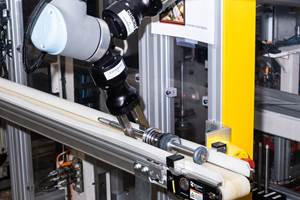The Role of Surface Finishing in Modern Manufacturing: Trends and Best Practices
You’re attending IMTS to advance your business. Regardless of your role in the manufacturing process, considering how your parts will be finished is crucial. This article can help you understand trends in surface finishing and better communicate with your finishing partners.
Share






At the International Manufacturing Technology Show (IMTS), industry professionals gather with a shared goal: advancing their businesses. Regardless of your role within the manufacturing process chain, it’s impotant to prioritize the finishing of your parts from the outset. Whether you manage finishing in-house or rely on outsourcing, early consideration of the final finish will help ensure quality.
The traditional approach of merely machining parts and sending them to a metal plater is outdated and should be left in the past. To achieve the highest quality, it’s essential to collaborate closely with every partner in your process chain, including surface finishing experts.
What are the current trends in surface finishing? Industry professionals are focusing on several key areas that shouldn’t come as a surprise.

GrayMatter Robotics provides artificial intelligence (AI)-driven software designed to enable robots to program themselves to perform surface finishing and surface prep operations for a wide variety of part sizes and shapes. Source: GrayMatter Robotics
1. AI, machine learning and IoT solutions
Much like other areas of manufacturing, finishers and coaters are seeking ways to streamline their processes. Today, finishers are increasingly exploring robotics, artificial intelligence (AI) and machine learning to tackle challenges such as workforce shortages, quality control and repeatability.
Historically, finishing operations have been slower to adopt IoT and automation solutions due to the high mix of parts typically processed by job shops, but various factors — including workforce trends and demands for environmentally responsible and sustainable processes — are accelerating the need to find new efficiencies.
Discover how one company is using AI to make finishing processes for a high mix of parts of varying geometries as easy as the push of a button.

These lattice cubes were 3D printed from clear resin using stereolithography, then coated by RePliForm with electroless nickel, copper and layers of ductile and hard nickel to improve their compression performance. Source: Additive Manufacturing
2. 3D Printing
Additive manufacturing is growing exponentially. As this technology continues to move from the realm of R&D and short run production to full scale production, an increasing number of fabricators are looking to various finishing methodologies to not only protect parts or provide aesthetics but in some cases to increase functionality.
Check out a story about how one company is using electroplating to enhance the physical properties of additively manufactured parts.

EVs present exciting new opportunities for additional growth of the use of electroless nickel plating in the automotive market for several critical components. Source: Getty Images
3. Electroless Nickel Plating and EVs
The advent of electric vehicles (EVs) seems to have finally arrived. With a growing number of automotive OEMs investing in new capabilities to grow their EV and hybrid offerings, finishes will be needed for a range of parts from electrical motor components to batteries.
One example is electroless nickel (EN) plating. EN has been used in the automotive industry for decades. Applications include piston heads, carburetors and fuel injection components, slip yokes and transmission components. Today, EVs present exciting new opportunities for additional growth of EN in the automotive market with the finish being used for several critical components used in electric vehicles.
Learn more about the role EN is playing in the developing EV market:

Powder coating overspray can be reclaimed and reused. Source: Innovakote
4. Environmental Considerations
Contrary to some perceptions, environmental concerns are a priority in the finishing industry. As one of the most heavily regulated sectors in manufacturing, compliance is essential for the industry’s sustainability. For years, metal finishers have been engaged in negotiations with environmental groups to address issues related to air quality and wastewater treatment. The industry has been proactive in seeking alternatives to potentially harmful hexavalent chromium finishing technologies, exploring safer options like trivalent chromium-based processes. The evolving regulatory landscape will continue to influence the available finishing technologies and their application methods.
This Products Finishing Ask the Expert column, discusses the environmental considerations driving some of these regulations:
In terms of coatings, powder coating has always been a low volatile organic compound (VOC) approach to coating parts, and powder overspray is a reclaimable material. Despite its already environmentally-friendly nature, new ways of making powder coating even more sustainable are being explored.
Check out this story about two companies that have found novel approaches to reclaiming powder.

This 3 D printed radar array is PAEK plated with layers of copper and electroless nickel using a plating on plastic activation chemistry known as GreenPOP. Source: Alliance Finishing and Manufacturing
5. Plating on Plastics
Plating on plastics (POP) isn’t new. Electroplating on plastic typically involves the process of depositing a thin layer of metal onto a plastic substrate using an electrochemical process after first preparing the plastic for the metal to adhere. Advances in plating on plastics, as well as the introduction of new materials aimed at producing lightweight parts are creating opportunities beyond traditional POP applications, which are often decorative in nature. Today, POP is being explored for use in diverse industries, including aerospace, automotive and electronics. The ability to electroplate on high-performance resins, lightweight composites and additively manufactured parts opens new avenues for innovation, making plating on plastic an option for enhancing functionality of parts in addition to providing esthetics.
Learn more about new innovations in plating on plastics:
Finishing today and tomorrow
The finishing industry is integral to the broader manufacturing landscape. Consumer needs and buying trends shape not only what we produce but also the methods we use. To ensure the highest quality for your parts, engage with your surface finishing partners early in the production process. Leverage their expertise to achieve the best possible surface finish, aligning with industry standards and consumer expectations.
Related Content
New Coolant Designed for Automotive Parts Production
Choosing the right coolant is critical for productivity, economic efficiency and machining quality.
Read MoreEliminating Automotive Defects Per Million With Automated Visual Inspection
This automotive manufacturer virtually eliminated PPM defect complaints after implementing an automated visual inspection system at its facility.
Read MoreSunnen Products Company Partners With Hendrick Motorsports
The partnership puts the new Sunnen SV-series honing machine in the Hendrick Motorsports engine operation alongside other Sunnen honing and engine building machines.
Read MoreThe Best of IMTS24 In Photos (We Saved the Best One for Last!)
From quadruped robot dogs, to an in-booth putting green where you can test out a new golf putter, to a 3D-printed car and more, attendees enjoyed cutting-edge technology and innovations all week long. Take a look to see what (or who!) you might have missed this week!
Read MoreRead Next
Last Chance! 2025 Top Shops Benchmarking Survey Still Open Through April 30
Don’t miss out! 91ÊÓƵÍøÕ¾ÎÛ's Top Shops Benchmarking Survey is still open — but not for long. This is your last chance to a receive free, customized benchmarking report that includes actionable feedback across several shopfloor and business metrics.
Read MoreMachine Shop MBA
Making Chips and 91ÊÓƵÍøÕ¾ÎÛ are teaming up for a new podcast series called Machine Shop MBA—designed to help manufacturers measure their success against the industry’s best. Through the lens of the Top Shops benchmarking program, the series explores the KPIs that set high-performing shops apart, from machine utilization and first-pass yield to employee engagement and revenue per employee.
Read MoreAMRs Are Moving Into Manufacturing: Considerations for Implementation
AMRs can provide a flexible, easy-to-use automation platform so long as manufacturers choose a suitable task and prepare their facilities.
Read More






















